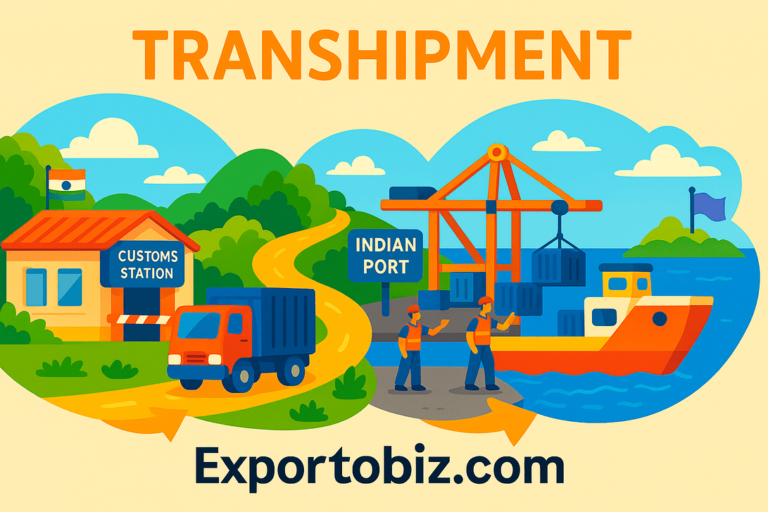On April 8, 2025, the Government of India withdrew a key transhipment facility that had been extended to Bangladesh for its export cargo. And this isn’t just another routine customs update, rather the move has sparked intense debate among trade pundits and diplomats alike.
Why? Because it’s expected to have far-reaching implications on Bangladesh’s export and trade ecosystem, especially its garment industry. The timing of this decision is quite crucial as it comes right when the U.S. has raised tariffs, putting additional pressure on Bangladesh’s export competitiveness.
And it’s not just what meets the eye. The Story also has a strong diplomatic flavor in itself: this withdrawal happened soon after Muhammad Yunus, Chief advisor to Bangladesh’s interim government, referred to India’s North-East as “landlocked” and claimed Bangladesh is the only gateway to the ocean , a comment that obviously has not gone down well with Indian policymakers.
In this article, let’s break down what this transhipment facility was all about, why India scrapped it, and what ripple effects it might create in the region
What is Transhipment?
Transhipment is a key logistics process where goods are moved from one mode of transport to another — or from one customs station to another — on their way to a final destination in a different country.
In simple terms, the goods enter a country’s customs station, but they’re not meant to stay there. Instead, they are moved further — usually to a port or airport — so they can be shipped to a third country. Since these goods aren’t meant for use or sale in the country allowing transhipment, no customs duty is charged.
This process is especially useful for landlocked countries or those with limited port access. It allows them to use the infrastructure of neighbouring countries to reach international markets.

Transhipment Facility for Bangladesh
The Government of India vide CBIC Circular No. 29/2020-Customs dated 22nd June 2020 allowed transhipment of Bangladeshi export cargo to third countries through India.
By availing this facility, Export cargo from Bangladesh, destined for Europe, could enter India through Land Customs Stations (LCSs), and then move to Indian ports like Kolkata Port, Nhava Sheva, or Kolkata Air Cargo Complex for final shipment.
This arrangement reduced shipping costs and cut down transit time, making it easier for Bangladeshi exporters, particularly those in the textile and readymade garment sector, to access international markets. It also allowed smoother trade for Bangladesh goods to Nepal, Bhutan and Myanmar.
New Development: Withdrawal of the Facility (Circular 13/2025-Customs)
On 8th April 2025, CBIC issued Circular No. 13/2025-Customs, officially rescinding Circular No. 29/2020-Customs with immediate effect.
This means the transhipment facility earlier available to Bangladeshi export cargo via Indian territory is no longer permitted.
Key Points:
- The transhipment facility has been withdrawn with immediate effect.
- Only cargo that had already entered India before the circular date will be allowed to exit using Indian ports or airports as per the earlier procedure.
- No fresh consignments can use the route via Indian Land Customs Stations (LCSs) for export to third countries.
Why Did India Withdraw the Transhipment Facility?
Let’s try to review what could be the possible reasons behind the decision to revoke the transhipment facility granted to Bangladeshi export cargo. It appears to be driven by a mix of geopolitical, strategic, and economic considerations:
- Diplomatic Tensions and Geopolitical Realignment
Well first what catches the attention is the timing of the decision. India’s move came soon after Muhammad Yunus, Chief Advisor to Bangladesh’s interim government, described India’s Northeast as “landlocked” and projected Bangladesh as the region’s only ocean access point during a visit to China. The tone and timing of Bangladesh were seen as provocative, particularly amidst Bangladesh’s increasing engagement with China.
- Security Concerns Near Sensitive Regions
Bangladesh has invited Chinese investment in critical infrastructure projects, including revitalizing an airbase near India’s Siliguri Corridor (“Chicken’s Neck”). This raised red flags in New Delhi regarding Chinese influence near strategic Indian territory.
- Domestic Industry and Long Pending Demand of AEPC
For long, India’s Apparel Export Promotion Council (AEPC) had been lobbying for the withdrawal of the transhipment facility. Bangladesh is a strong competitor in the global textile and garment sector. By facilitating Bangladeshi cargo through Indian ports, As per AEPC, India was offering a logistical advantage to Bangladesh, especially for exports headed to Europe. AEPC argued that ending this facility would help create a level playing field and ease the strain on Indian exporters.
- Port Congestion and Increased Freight Costs
Major Indian ports like Kolkata and Nhava Sheva faced rising congestion due to transhipped Bangladeshi cargo. This slowed domestic operations, increased handling delays, and added to already soaring freight and terminal handling charges, hurting Indian exporters.
- Easing Pressure Amid Global Trade Challenges
India’s textile industry is already under stress from global competition amid increased tariffs by the United States. Revoking the transhipment facility would help in reducing external competitive advantages and offers some relief to domestic manufacturers by streamlining logistics and reducing port congestion.
- Regulatory and Security Oversight
Allowing foreign cargo to pass through Indian customs corridors poses regulatory and security risks, especially when geopolitical dynamics are shifting and realigning. Stricter control over what passes through Indian territory, and who benefits from it reflects a cautious and calculated regulatory stance.

EXPORTOBIZ Comments
Exportobiz believes that India’s decision to revoke the transhipment facility will further strain Bangladesh’s export sector, particularly its textile and readymade garments (RMG) industry. With rising global competition and recent tariff hikes by major markets like the U.S., the absence of access to Indian transit routes could lead to higher logistics costs, longer transit times, and reduced competitiveness for Bangladesh exporters.
Key Implications:
- Bangladeshi exporters and freight forwarders will now need to rely on direct shipping routes or seek alternative transit pathways and factor in the extra cost.
- Indian logistics partners, particularly those involved in transporting transhipped consignments from Land Customs Stations (LCSs) to Indian ports, are likely to witness a decline in business volume, as this segment was previously driven by Bangladeshi export cargo routed through India
- Exports from Bangladesh to neighbouring countries such as Nepal, Bhutan, and Myanmar—which also relied on Indian transit routes—may experience major logistical setbacks.
- The decision may disrupt regional supply chain efficiency and lead to a rise in logistics costs for Bangladeshi products, ultimately making their exports less price-competitive in international markets.

CA Kalpak Kaplash
Expert in GST, Customs & Foreign Trade Policy (FTP) He is passionate about simplifying tax & trade for Indian exporters. Author can be reached out at kalpak.kaplash@gmail.com



